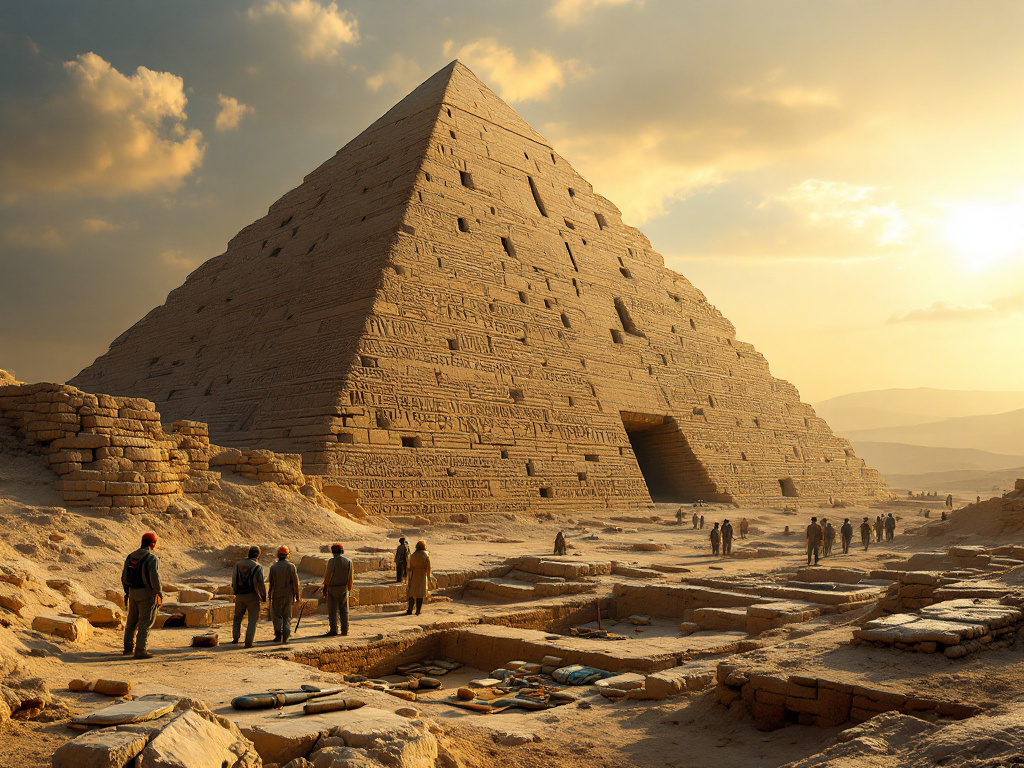A 2200-Year-Old Pyramid in the Judean Desert: A Discovery That Rewrites Ancient Israel’s History
An Exceptional Archaeological Discovery
In the heart of the Judean Desert, just north of Nahal Zohar, near the Dead Sea, archaeologists have recently unearthed an extraordinary discovery: a pyramid that dates back about 2200 years. This mysterious structure, which had never been documented before, could shed new light on the history of ancient Israel and the civilizations that once inhabited the region. With the discovery of ancient papyri, bronze coins, and remarkably well-preserved artifacts, archaeologists are striving to understand the purpose of this pyramid and how it fits into the historical context of the Hellenistic period.
The Discovery in the Heart of the Desert: An Enigmatic Architecture
The discovery was announced in March 2025 by the Israel Antiquities Authority (IAA). The pyramid, standing approximately six meters tall and built with massive limestone blocks, has been identified as a monumental structure from the Hellenistic period. It is hypothesized that the pyramid was not a tomb, as many other similar structures are, but rather a fortress or watchtower. This makes it a unique find, as there are few pyramids of this type in the region.
The pyramid is located in a strategically significant area of the Judean Desert, historically a crossroads for trade and cultural exchanges between the major powers of the time, from the Ptolemies of Egypt to the Seleucids of Syria. This new discovery is particularly important because it may provide insights into the control of trade routes and administrative practices in this arid region.
The Found Artifacts: Exceptional Testimonies of a Remote Past
The artifacts found inside the pyramid are remarkable and offer new insights into life during the Hellenistic period. Among the most significant finds are papyri written in Greek, the language of the Hellenistic world, which describe administrative and commercial practices of the time. The papyri are in excellent condition, thanks to the dry desert climate, and are considered a treasure for archaeologists, offering a unique window into the everyday life of the region’s inhabitants.
In addition, bronze coins have been discovered, some issued by the Ptolemaic dynasty and others from the reign of Antiochus IV, a Seleucid ruler who ruled Syria in the 2nd century BCE. These coins help date the pyramid and reconstruct the chronology of the site’s occupation.
Other finds include weapons, wooden tools, and textiles, all in remarkable condition. These artifacts are significant not only because of their rarity but also because they suggest the pyramid was used as an administrative center or a defensive structure, rather than merely as a monumental tomb.
A Discovery That Rewrites History: A Place of Power and Control
For a long time, archaeologists associated the Judean Desert with sites of refuge for hermits and rebels. However, the discovery of this pyramid suggests that the region may also have served as a center of administrative control and tax collection. The structure could have been used as a fortress to control commercial routes and collect taxes from traders, as indicated by the papyri found. This discovery opens new avenues for understanding the management of trade and the power dynamics in the Judean Desert during the Hellenistic period.
The trade routes that passed through the Judean Desert were crucial for the exchange of valuable goods such as spices, metals, textiles, and luxury items. The presence of a pyramid suggests a strategic checkpoint where local authorities may have collected taxes or levies from travelers, acting as a center for control. Archaeologists believe the pyramid was part of a network of fortifications designed to protect these trade routes and manage the flow of goods and resources.
The Historical Context of the Judean Desert: A Region Between Great Powers
In the 2nd century BCE, the Judean Desert found itself in the midst of a struggle between the Ptolemies of Egypt and the Seleucids of Syria. During this period, the Judean region was not yet an independent state but was governed by these two Hellenistic powers, who sought to extend their influence over the area. The discovery of the pyramid and related artifacts may provide further details about this turbulent period, when local populations, while under foreign rule, were developing their own organizational structures and capacities for resistance.
Thus, the pyramid may not only represent a symbol of local power but also a defensive center against foreign invasions or attempts at conquest. Its location in the Judean Desert further enhances its importance as a strategic observation and defense point.
A Key Piece of Ancient Israel’s History
The discovery of the pyramid in the Judean Desert is one of the most significant archaeological finds of recent decades. It provides new insights into the architectural structures of the Hellenistic period and offers a deeper understanding of the political, economic, and cultural dynamics of ancient Israel. The discovery of papyri, coins, and other artifacts is a tangible link to how the region was managed and governed, shedding light on the daily lives of its inhabitants.
Each new discovery brings us closer to rewriting the history of ancient Israel, adding new chapters to a narrative that continues to evolve thanks to cutting-edge technologies and discoveries like this.








Leave a Comment